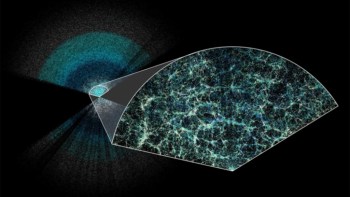
Astronomers studying the cosmic microwave background (CMB) have uncovered new direct evidence for dark energy – the mysterious substance that appears to be accelerating the expansion of the universe. Their findings could also help map the structure of dark matter on the universe’s largest length scales.
The CMB is the faint afterglow of the universe’s birth in the Big Bang. Around 400,000 years after its creation, the universe had cooled sufficiently to allow electrons to bind to atomic nuclei. This “recombination” set the CMB radiation free from the dense fog of plasma that was containing it. Space telescopes such as WMAP and Planck have charted the CMB and found its presence in all parts of the sky, with a temperature of 2.7 K. However, measurements also show tiny fluctuations in this temperature on the scale of one part in a million. These fluctuations follow a Gaussian distribution.
In the first of two papers, a team of astronomers including Sudeep Das at the University of California, Berkeley, has uncovered fluctuations in the CMB that deviate from this Gaussian distribution. The deviations, observed with the Atacama Cosmology Telescope in Chile, are caused by interactions with large-scale structures in the universe, such as galaxy clusters. “On average, a CMB photon will have encountered around 50 large-scale structures before it reaches our telescope,” Das told physicsworld.com. “The gravitational influence of these structures, which are dominated by massive clumps of dark matter, will each deflect the path of the photon,” he adds. This process, called “lensing”, eventually adds up to a total deflection of around 3 arc minutes – one-20th of a degree.
Dark energy versus structure
In the second paper Das, along with Blake Sherwin of Princeton University and Joanna Dunkley of Oxford University, looks at how lensing could reveal dark energy. Dark energy acts to counter the emergence of structures within the universe. A universe with no dark energy would have a lot of structure. As a result, the CMB photons would undergo greater lensing and the fluctuations would deviate more from the original Gaussian distribution.
However, the opposite was found to be true. “We see too little lensing to account for a universe with no dark energy,” Sherwin told physicsworld.com. “In fact, the amount of lensing we see is consistent with the amount of dark energy we would expect to see from other measurements.”
This is the first time dark energy has been inferred from measurements of the CMB alone. Conventional CMB measurements only reveal details about the very early universe, a time before stars and galaxies. In order to build up a picture of the universe’s evolution, these results had to be combined with an additional measurement such as the Hubble constant. However, the CMB photons observed in this work were deflected by the unfolding evolution of the universe. “That missing information is now built right in,” Sherwin explains.
“Patchwork of evidence”
The fact that this is direct evidence, rather than relying on a second measurement, excites Stephen Boughn, a cosmologist at Haverford College in the US. “We currently only have two pieces of direct evidence for dark energy. Any additional evidence that indicates its existence is very important,” he says. “We want a patchwork of evidence, from many different places, just to make sure the whole picture hangs together. This work helps with that.”
Boughn also believes that the findings could help reveal how dark matter is distributed throughout the universe on large scales. Dark matter has the same gravitational effects as normal matter but does not interact with electromagnetic radiation and so cannot be seen directly. “There are many simulations, but few observations, that suggest how the universe’s dark matter is structured,” he explains. “But because this lensing of the microwave background depends on how the dark matter is clumped, future experiments measuring these distortions in the CMB should be able to get a handle on how large-scale dark matter is distributed.”
The both papers are published in Physical Review Letters.



